Issues and Opportunities Associated with Trophy Hunting and Tourism in Khunjerab National Park, Northern Pakistan
Abstract
Simple Summary
Abstract
1. Introduction
2. Materials and Methods
2.1. Study Area
2.2. Data Collection
3. Results
3.1. Conservation Impact of Trophy Hunting
3.1.1. Perception about the Wild Trophy Ungulates
3.1.2. Perception about the Wild Carnivores in the Community
3.1.3. Community Perception about the Impact of Trophy Hunting on Retaliatory Killing of Snow Leopards
3.1.4. Opinions about Continuity of Trophy Hunting in the Future
One of the problems with trophy hunting in KVO’s CCHA was the lack of population census or survey of the trophy ungulates in recent years and the annual quotas for trophy hunting were estimated subjectively. Additionally, the required age of a single trophy ungulate should be about 12 years old, but most trophy animals were much younger than this. The population sizes of trophy ungulates were decreasing at a faster rate in recent years, so the trophy hunting program in KVO’s CCHA was unsustainable. Proper scientific surveys were required for determining the number of trophy animals to be harvested in a single year. Moreover, trophy hunting in KVO’s CCHA should be stopped at the earliest for the benefits of wild ungulates. Instead, some conservation-friendly alternative to trophy hunting was desired.(FGD with KVO’s Officials)
3.1.5. Livestock Holdings and Livestock Depredation
3.2. Economic Returns of Trophy Hunting Program in KVO’s CCHA
3.3. Mass Tourism and Its Economic Benefits
3.4. Comparison between Trophy Hunting and Mass Tourism
3.5. Perception of National Park Staff about Mass Tourism Inside KVO’s KNP
An estimated 4 Ibex and some other animals were killed per year in collisions with vehicles inside KVO’s KNP due to the lack of protection/fence on both sides of the road. Mass tourism has also resulted in pollution inside KVO’s KNP, which could be observed along the main road. The solid wastes are impacting the serene environment inside KVO’s KNP, and wild animals at times consume these wastes. In addition, noise from traffic disturbs wildlife inside the park.(FGD with national park officials)
3.6. Impact of Infrastructure on Tourism Inside the Park
4. Discussion
4.1. Trophy Hunting: Its Impacts on Trophy Ungulates
4.2. Trophy Hunting: Its Impacts on Carnivores
4.3. Trophy Hunting: Its Economic Benefits and Future
4.4. Mass Tourism: Its Economic Benefits, Environmental Problems and Future
5. Conclusions
Supplementary Materials
Author Contributions
Funding
Acknowledgments
Conflicts of Interest
References
- Lindsey, P.A.; Roulet, P.A.; Romanach, S.S. Economic and conservation significance of the trophy hunting industry in sub-Saharan Africa. Biol. Conserv. 2007, 134, 455–469. [Google Scholar] [CrossRef]
- Naidoo, R.; Weaver, L.C.; Diggle, R.W.; Matongo, G.; Stuart-Hill, G.; Thouless, C. Complementary benefits of tourism and hunting to communal conservancies in Namibia. Conserv. Biol. 2016, 30, 628–638. [Google Scholar] [CrossRef] [PubMed]
- Angula, H.N.; Stuart-Hill, G.; Ward, D.; Matongo, G.; Diggle, R.W.; Naidoo, R. Local perceptions of trophy hunting on communal lands in Namibia. Biol. Conserv. 2018, 218, 26–31. [Google Scholar] [CrossRef]
- Mysterud, A. Trophy hunting with uncertain role for population dynamics and extinction of ungulates. Anim. Conserv. 2012, 15, 14–15. [Google Scholar] [CrossRef]
- Naevdal, E.; Olaussen, J.O.; Skonhoft, A. A bioeconomic model of trophy hunting. Ecol. Econ. 2012, 73, 194–205. [Google Scholar] [CrossRef]
- Woodford, M.H.; Frisina, M.R.; Awan, G.A. The Torghar Conservation Project: Management of the Livestock, Suleiman Markhor (Capra Falconeri) And Afghan Urial (Ovis Orientalis) in the Torghar Hills, Pakistan. Game Wildl. Sci. 2004, 21, 177–187. [Google Scholar]
- Leader-Williams, N.; Milledge, S.; Adcock, K.; Brooks, M.; Conway, A.; Knight, M.; Mainka, S.; Martin, E.B.; Teferi, T. Trophy Hunting of Black Rhino Diceros bicornis: Proposals to Ensure Its Future Sustainability. J. Int. Wildl. Law Policy 2005, 8, 1–11. [Google Scholar] [CrossRef]
- Pasmans, T.; Hebinck, P. Rural development and the role of game farming in the Eastern Cape, South Africa. Land Use Policy 2017, 64, 440–450. [Google Scholar] [CrossRef]
- Yasuda, A. The Impacts of Sport Hunting on the Livelihoods of Local People: A Case Study of Bénoué National Park, Cameroon. Soc. Nat. Resour. 2011, 24, 860–869. [Google Scholar] [CrossRef]
- Harris, R.B.; Pletscher, D.H. Incentives toward conservation of argali Ovis ammon: A case study of trophy hunting in western China. Oryx 2002, 36, 373–381. [Google Scholar] [CrossRef]
- Nordbo, I.; Turdumambetov, B.; Gulcan, B. Local opinions on trophy hunting in Kyrgyzstan. J. Sustain. Tour. 2017, 26, 1–17. [Google Scholar] [CrossRef]
- Lindsey, P.A.; Balme, G.A.; Funston, P.; Henschel, P.; Hunter, L.; Madzikanda, H.; Midlane, N.; Nyirenda, V. The Trophy Hunting of African Lions: Scale, Current Management Practices and Factors Undermining Sustainability. PLoS ONE 2013, 8, e0073808. [Google Scholar] [CrossRef] [PubMed]
- Baker, J.E. Trophy Hunting as a Sustainable Use of Wildlife Resources in Southern and Eastern Africa. J. Sustain. Tour. 1997, 5, 306–321. [Google Scholar] [CrossRef]
- Croes, B.M.; Funston, P.J.; Rasmussen, G.; Buij, R.; Saleh, A.; Tumenta, P.N.; De Iongh, H.H. The impact of trophy hunting on lions (Panthera leo) and other large carnivores in the Bénoué Complex, northern Cameroon. Biol. Conserv. 2011, 144, 3064–3072. [Google Scholar] [CrossRef]
- Caro, T.M.; Young, C.R.; Cauldwell, A.E.; Brown, D.D. Animal breeding systems and big game hunting: Models and application. Biol. Conserv. 2009, 142, 909–929. [Google Scholar] [CrossRef]
- Lindsey, P.A.; Balme, G.A.; Funston, P.J.; Henschel, P.H.; Hunter, L.T. Life after Cecil: Channelling global outrage into funding for conservation in Africa. Conserv. Lett. 2016, 9, 296–301. [Google Scholar] [CrossRef]
- Palazy, L.; Bonenfant, C.; Gaillard, J.M.; Courchamp, F. Rarity, trophy hunting and ungulates. Anim. Conserv. 2011, 15, 4–11. [Google Scholar] [CrossRef]
- Aryal, A.; Morley, C.G.; Cowan, P.; Ji, W. Conservation trophy hunting: Implications of contrasting approaches in native and introduced-range countries. Biodiversity 2017, 17, 1–3. [Google Scholar] [CrossRef]
- Aryal, A.; Dhakal, M.; Panthi, S.; Yadav, B.P.; Shrestha, U.B.; Bencini, R.; Raubenheimer, D.; Ji, W. Is trophy hunting of bharal (blue sheep) and Himalayan tahr contributing to their conservation in Nepal? Hystrix 2015, 26, 85–88. [Google Scholar] [CrossRef]
- Milner, J.M.; Nilsen, E.B.; Andreassen, H.P. Demographic Side Effects of Selective Hunting in Ungulates and Carnivores. Conserv. Biol. 2007, 21, 36–47. [Google Scholar] [CrossRef]
- Creel, S.; M’soka, J.; Dröge, E.; Rosenblatt, E.; Becker, M.; Matandiko, W.; Simpamba, T. Assessing the sustainability of African lion trophy hunting, with recommendations for policy. Ecol. Appl. 2016, 26, 2347–2357. [Google Scholar] [CrossRef] [PubMed]
- Muposhi, V.K.; Gandiwa, E.; Makuza, S.M.; Bartels, P. Ecological, Physiological, Genetic Trade-Offs and Socio-economic implications of trophy hunting as a conservation tool: A narrative review. J. Anim. Plant Sci. 2017, 27, 1–14. [Google Scholar]
- Packer, C.; Kosmala, M.; Cooley, H.S.; Brink, H.; Pintea, L.; Garshelis, D.; Purchase, G.; Strauss, M.; Swanson, A.; Balme, G.; et al. Sport Hunting, Predator Control and Conservation of Large Carnivores. PLoS ONE 2009, 4, e5941. [Google Scholar] [CrossRef] [PubMed]
- Crosmary, W.-G.; Loveridge, A.J.; Ndaimani, H.; Lebel, S.; Booth, V.; Côté, S.D.; Fritz, H. Trophy hunting in Africa: Long-term trends in antelope horn size. Anim. Conserv. 2013, 16, 648–660. [Google Scholar] [CrossRef]
- Coulson, T.; Schindler, S.; Traill, L.; Kendall, B.E. Predicting the Evolutionary Consequences of Trophy Hunting on a Quantitative Trait. J. Wildl. Manag. 2018, 82, 46–56. [Google Scholar] [CrossRef]
- Allendorf, F.W.; England, P.R.; Luikart, G.; Ritchie, P.A.; Ryman, N. Genetic effects of harvest on wild animal populations. Trends Ecol. Evol. 2008, 23, 327–337. [Google Scholar] [CrossRef]
- Hussain, S. The status of the snow leopard in Pakistan and its conflict with local farmers. Oryx 2003, 37, 26–33. [Google Scholar] [CrossRef]
- Teichman, K.J.; Cristescu, B.; Darimont, C.T. Hunting as a management tool? Cougar-human conflict is positively related to trophy hunting. BMC Ecol. 2016, 16, 44. [Google Scholar] [CrossRef]
- Rosenblatt, E.; Becker, M.S.; Creel, S.; Droge, E.; Mweetwa, T.; Schuette, P.A.; Watson, F.; Merkle, J.; Mwape, H. Detecting declines of apex carnivores and evaluating their causes: An example with Zambian lions. Biol. Conserv. 2014, 180, 176–186. [Google Scholar] [CrossRef]
- Rashid, W.; Shi, J.; Rahim, I.U.; Sultan, H.; Dong, S.; Ahmad, L. Research trends and management options in human-snow leopard conflict. Biol. Conserv. 2020, 242, 108413. [Google Scholar] [CrossRef]
- Davenport, J.; Davenport, J.L. The impact of tourism and personal leisure transport on coastal environments: A review. Estuar. Coast. Shelf Sci. 2006, 67, 280–292. [Google Scholar] [CrossRef]
- Wang, S.; Du, J.; Li, S.; He, H.; Xu, W. Impact of tourism activities on glacial changes based on the tourism heat footprint (THF) method. J. Clean. Prod. 2019, 215, 845–853. [Google Scholar] [CrossRef]
- Kuvan, Y. Mass Tourism Development and Deforestation in Turkey. Anatolia 2010, 21, 155–168. [Google Scholar] [CrossRef]
- Ozturk, I.; Al-Mulali, U.; Saboori, B. Investigating the environmental Kuznets curve hypothesis: The role of tourism and ecological footprint. Environ. Sci. Pollut. Res. 2015, 23, 1916–1928. [Google Scholar] [CrossRef]
- Saenz-de-Miera, O.; Rosselló, J. Modeling tourism impacts on air pollution: The case study of PM10 in Mallorca. Tour. Manag. 2014, 40, 273–281. [Google Scholar] [CrossRef]
- Hausmann, A.; Toivonen, T.; Heikinheimo, V.; Tenkanen, H.; Slotow, R.; Minin, E.D. Social media reveal that charismatic species are not the main attractor of ecotourists to sub-Saharan protected areas. Sci. Rep. 2017, 7, 763. [Google Scholar] [CrossRef]
- Tsaur, S.-H.; Lin, Y.-C.; Lin, J.-H. Evaluating ecotourism sustainability from the integrated perspective of resource, community and tourism. Tour. Manag. 2006, 27, 640–653. [Google Scholar] [CrossRef]
- Brightsmith, D.J.; Stronza, A.; Holle, K. Ecotourism, conservation biology, and volunteer tourism: A mutually beneficial triumvirate. Biol. Conserv. 2008, 141, 2832–2842. [Google Scholar] [CrossRef]
- Novelli, M.; Barnes, J.I.; Humavindu, M. The Other Side of the Ecotourism Coin: Consumptive Tourism in Southern Africa. J. Ecotour. 2006, 5, 62–79. [Google Scholar] [CrossRef]
- Jew, E.; Bonnington, C. Socio-demographic factors influence the attitudes of local residents towards trophy hunting activities in the Kilombero Valley, Tanzania. Afr. J. Ecol. 2011, 49, 277–285. [Google Scholar] [CrossRef]
- Buckley, R.; Mossaz, A. Hunting tourism and animal conservation. Anim. Conserv. 2015, 18, 133–135. [Google Scholar] [CrossRef]
- Khan, B.; Ablimit, A.; Khan, G.; Jasra, A.W.; Ali, H.; Ali, R.; Ahmad, E.; Ismail, M. Abundance, distribution and conservation status of Siberian ibex, Marco Polo and Blue sheep in Karakoram-Pamir mountain area. J. King Saud. Univ. Sci. 2016, 28, 216–225. [Google Scholar] [CrossRef]
- Khan, B.; Abdukadir, A.; Qureshi, R.; Mustafa, G. Medicinal uses of plants by the inhabitants of Khunjerab national park, Gilgit, Pakistan. Pak. J. Bot. 2011, 43, 2301–2310. [Google Scholar]
- PGoGB. Re-Notification of the Boundaries of Khunjerab National Park, Hunza-Nagar; F&A-8 (4)/F/2001; Forest, Wildlife and Environment, Provincial Government of Gilgit Baltistan: Gilgit, Pakistan, 2010; pp. 1–12. [Google Scholar]
- Mir, A. Impact Assessment of Community Based Trophy Hunting in MACP areas of NWFP and Northern Areas. In Mountain Areas Conservancy Project (MACP); IUCN Islamabad Program Office: Islamabad, Pakistan, 2006; p. 38. [Google Scholar]
- Khattak, R.H.; Ali, H.; Rehman, E.U.; Nawaz, M.A. Population Structure of Blue Sheep (Pseudios nayaur) in Shimshal Valley Gilgit-Baltistan Pakistan. Pak. J. Zool. 2019, 52, 699–707. [Google Scholar] [CrossRef]
- Shafiq, M.M.; Ali, A. Status of large mammal species in Khunjerab National Park. Pak. J. For. 1998, 48, 92–96. [Google Scholar]
- Knudsen, A. Conservation and Controversy in the Karakoram: Khunjerab National Park, Pakistan. J. Polit. Ecol. 1999, 6, 1–30. [Google Scholar] [CrossRef][Green Version]
- Ali, S.; Gao, J.; Begum, F.; Rasool, A.; Ismail, M.; Cai, Y.; Ali, S.; Ali, S. Health assessment using aqua-quality indicators ofalpine streams (Khunjerab National Park), Gilgit, Pakistan. Environ. Sci. Pollut. Res. 2016, 24, 4685–4698. [Google Scholar] [CrossRef]
- Shackleton, D.M. A Review of Community-Based Trophy Hunting Programs in Pakistan; The World Conservation Union (IUCN-Pakistan): Islamabad, Pakistan, 2001; pp. 1–59. [Google Scholar]
- Nyumba, T.O.; Wilson, K.; Derrick, C.J.; Mukherjee, N. The use of focus group discussion methodology: Insights from two decades of application in conservation. Methods Ecol. Evol. 2018, 9, 20–32. [Google Scholar] [CrossRef]
- Chakraborty, S.; Gasparatos, A. Community values and traditional knowledge for coastal ecosystem services management in the “satoumi” seascape of Himeshima island, Japan. Ecosyst. Serv. 2019, 37, 100940. [Google Scholar] [CrossRef]
- Mukherjee, N.; Zabala, A.; Huge, J.; Nyumba, T.O.; Esmail, B.A.; Sutherland, W.J. Comparison of techniques for eliciting views and judgements in decision-making. Methods Ecol. Evol. 2018, 9, 54–63. [Google Scholar] [CrossRef]
- Sutherland, W.J.; Dicks, L.V.; Everard, M.; Geneletti, D. Qualitative methods for ecologists and conservation scientists. Methods Ecol. Evol. 2018, 9, 7–9. [Google Scholar] [CrossRef]
- Dube, N. Voices from the village on trophy hunting in Hwange district, Zimbabwe. Ecol. Econ. 2019, 159, 335–343. [Google Scholar] [CrossRef]
- Jamal, S. Requests to increase Markhor’s trophy hunting permits declined. Dawn 2019. [Google Scholar]
- Jackson, R. Pakistan’s Community-based Trophy Hunting Programs and Their Relationship to Snow Leopard Conservation; Snow Leopard Conservancy: Sonoma, CA, USA, 2004; pp. 1–8. [Google Scholar]
- Frisina, M.R.; Awan, G.A.; Woodford, M.H. Determining trophy harvest quotas through a status survey of urial (Ovis orientalis) in the Kalabagh game reserve, Punjab province, Pakistan. J. Bombay Nat. Hist. Soc. 2007, 104, 35–39. [Google Scholar]
- Frisina, M.R.; Wood, C.; Woodford, M. Population Trend of Suleiman Markhor (Capra falconeri jerdoni) and Afgan Urial (Ovis orientalis cycloceros), With Reference to Habitat Conditions, Torghar Hills, Baluchistan Province, Pakistan; United States Fish and Wildlife Service Office of International Affairs And Society for Torghar Environmental Protection (STEP): Washington, DC, USA, 1998. [Google Scholar]
- Fenberg, P.B.; Roy, K. Ecological and evolutionary consequences of size-selective harvesting: How much do we know? Mol. Ecol. 2008, 17, 209–220. [Google Scholar] [CrossRef] [PubMed]
- Packer, C.; Brink, H.; Kissui, B.M.; Maliti, H.; Kushnir, H.; Caro, T. Effects of trophy hunting on lion and leopard populations in Tanzania. Conserv. Biol. 2011, 25, 142–153. [Google Scholar] [CrossRef] [PubMed]
- Hockley, N.J.; Jones, J.P.G.; Andriahajaina, F.B.; Manica, A.; Ranambitsoa, E.H.; Randriamboahary, J.A. When should communities and conservationists monitor exploited resources? Biodivers. Conserv. 2005, 14, 2795–2806. [Google Scholar] [CrossRef]
- Frost, P.G.; Bond, I. The CAMPFIRE programme in Zimbabwe: Payments for wildlife services. Ecol. Econ. 2008, 65, 776–787. [Google Scholar] [CrossRef]
- Frisina, M.R.; Tareen, S.N.A. Recreational Hunting, Conservation and Rural Livelihoods. In Recreational Hunting, Conservation and Rural Livelihoods: Science and Practice; Dickson, B., Hutton, J., Adams, W.M., Eds.; Blackwell Publishing Ltd.: Oxford, UK, 2009; pp. 141–156. [Google Scholar]
- Mijiddorj, T.N.; Alexander, J.S.; Samelius, G. Livestock depredation by large carnivores in the South Gobi, Mongolia. Wildl. Res. 2018, 45, 237–247. [Google Scholar] [CrossRef]
- Kachel, S.M.; McCarthy, K.P.; McCarthy, T.M.; Oshurmamadov, N. Investigating the potential impact of trophy hunting of wild ungulates on snow leopard Panthera uncia conservation in Tajikistan. Oryx 2016, 51, 597–604. [Google Scholar] [CrossRef]
- Sharma, R.K.; Bhatnagar, Y.V.; Mishra, C. Does livestock benefit or harm snow leopards? Biol. Conserv. 2015, 190, 8–13. [Google Scholar] [CrossRef]
- Rosen, T.; Hussain, S.; Mohammad, G.; Jackson, R.; Janecka, J.E.; Michel, S. Reconciling Sustainable Development of Mountain Communities With Large Carnivore Conservation. Mt. Res. Dev. 2012, 32, 286–293. [Google Scholar] [CrossRef]
- Saayman, M.; Merwe, P.; Saayman, A. The economic impact of trophy hunting in the South African wildlife industry. Glob. Ecol. Conserv. 2018, 16, e00510. [Google Scholar] [CrossRef]
- Meinard, Y.; Dereniowska, M.; Gharbi, J.-S. The ethical stakes in monetary valuation methods for conservation purposes. Biol. Conserv. 2016, 199, 67–74. [Google Scholar] [CrossRef]
- Qi, J.; Holyoak, M.; Ning, Y.; Jiang, G. Ecological thresholds and large carnivores conservation: Implications for the Amur tiger and leopard in China. Glob. Ecol. Conserv. 2019, 21, e00837. [Google Scholar] [CrossRef]
- Gomez-Baggethun, E.; Ruiz-Perez, M. Economic valuation and the commodification of ecosystem services. Prog. Phys. Geogr. 2011, 35, 613–628. [Google Scholar] [CrossRef]
- Gren, I.-M.; Häggmark-Svensson, T.; Elofsson, K.; Engelmann, M. Economics of wildlife management—An overview. Eur. J. Wildl. Res. 2018, 64, 22. [Google Scholar] [CrossRef]
- Wallach, A.D.; Bekoff, M.; Batavia, C.; Nelson, M.P.; Ramp, D. Summoning compassion to address the challenges of conservation. Conserv. Biol. 2018, 32, 1255–1265. [Google Scholar] [CrossRef]
- Batavia, C.; Bruskotter, J.T.; Jones, J.A.; Vucetich, J.A.; Gosnell, H.; Nelson, M.P. Nature for whom? How type of beneficiary influences the effectiveness of conservation outreach messages. Biol. Conserv. 2018, 228, 158–166. [Google Scholar] [CrossRef]
- Temel, J.; Jones, A.; Jones, N.; Balint, L. Limits of monetization in protecting ecosystem services. Conserv. Biol. 2018, 32, 1048–1062. [Google Scholar] [CrossRef]
- Bruskotter, J.T.; Vucetich, J.A.; Dietsch, A.; Slagle, K.M.; Brooks, J.S.; Nelson, M.P. Conservationists’ moral obligations toward wildlife: Values and identity promote conservation conflict. Biol. Conserv. 2019, 240, 108296. [Google Scholar] [CrossRef]
- Pearson, R.G. Reasons to Conserve Nature. Trends Ecol. Evol. 2016, 31, 366–371. [Google Scholar] [CrossRef] [PubMed]
- Nelson, M.P.; Bruskotter, J.T.; Vucetich, J.A.; Chapron, G. Emotions and the Ethics of Consequence in Conservation Decisions: Lessons from Cecil the Lion. Conserv. Lett. 2016, 9, 302–306. [Google Scholar] [CrossRef]
- Dickman, A.; Packer, C.; Johnson, P.J.; Macdonald, D.W. A sideways look at conservation and consistency in tourism policy. Conserv. Biol. 2018, 32, 744–746. [Google Scholar] [CrossRef]
- Sirivongs, K.; Tsuchiya, T. Relationship between local residents’ perceptions, attitudes and participation towards national protected areas: A case study of Phou Khao Khouay National Protected Area, central Lao PDR. For. Policy Econ. 2012, 21, 92–100. [Google Scholar] [CrossRef]
- Al-Tokhais, A.; Thapa, B. Stakeholder Perspectives towards National Parks and Protected Areas in Saudi Arabia. Sustainability 2019, 11, 2323. [Google Scholar] [CrossRef]
- Cook, N.; Butz, D. Mobility Justice in the Context of Disaster. Mobilities 2015, 11, 400–419. [Google Scholar] [CrossRef]
- Manzoor, F.; Wei, L. A Review of China-Pakistan Economic Corridor and Tourism Opportunities. Adv. Econ. Manag. Bus. Res. 2018, 56, 79–82. [Google Scholar]
- Kanwal, S.; Rasheed, M.I.; Pitafi, A.H.; Pitafi, A.; Ren, M. Road and transport infrastructure development and community support for tourism: The role of perceived benefits, and community satisfaction. Tour. Manag. 2019, 77, 104014. [Google Scholar] [CrossRef]
- Kiss, A. Is community-based ecotourism a good use of biodiversity conservation funds? Trends Ecol. Evol. 2004, 19, 232–237. [Google Scholar] [CrossRef]
- Hawkins, D.E.; Mann, S. The World Bank’s role in tourism development. Ann. Tour. Res. 2007, 34, 348–363. [Google Scholar] [CrossRef]
- Chong, K.L. The side effects of mass tourism: The voices of Bali islanders. Asia Pac. J. Tour. Res. 2019, 25, 157–169. [Google Scholar] [CrossRef]
- Habibi, F.; Rahmati, M.; Karimi, A. Contribution of tourism to economic growth in Iran’s Provinces: GDM approach. Future Bus. J. 2018, 4, 261–271. [Google Scholar] [CrossRef]
- Zorpas, A.A.; Voukkali, I.; Pedreño, J.N. Tourist area metabolism and its potential to change through a Proposed Strategic Plan in the framework of Sustainable Development. J. Clean. Prod. 2018, 172, 3609–3620. [Google Scholar] [CrossRef]
- Alipour, H.; Arefipour, T. Rethinking potentials of Co-management for sustainable common pool resources (CPR) and tourism: The case of a Mediterranean island. Ocean Coast Manag. 2019, 183, 104993. [Google Scholar] [CrossRef]
- Fantinato, E. The impact of (mass) tourism on coastal dune pollination networks. Biol. Conserv. 2019, 236, 70–78. [Google Scholar] [CrossRef]
- Rico, A.; Martínez-Blanco, J.; Montlleó, M.; Rodríguez, G.; Tavares, N.; Arias, A.; Oliver-Solà, J. Carbon footprint of tourism in Barcelona. Tour. Manag. 2019, 70, 491–504. [Google Scholar] [CrossRef]
- Akis, A. The effects of mass tourism: A case study from Manavgat (Antalya—Turkey). Procedia Soc. Behav. Sci. 2011, 19, 289–296. [Google Scholar] [CrossRef]
- Herrera, M.R.G.; Sasidharan, V.; Hernández, J.A.Á.; Herrera, L.D.A. Quality and sustainability of tourism development in Copper Canyon, Mexico: Perceptions of community stakeholders and visitors. Tour. Manag. Perspect. 2018, 27, 91–103. [Google Scholar] [CrossRef]
- Andereck, K.L.; Valentine, K.M.; Knopf, R.C.; Vogt, C.A. Residents’ perceptions of community tourism impacts. Ann. Tour. Res. 2005, 32, 1056–1076. [Google Scholar] [CrossRef]
- Almeida-García, F.; Pelaez-Fernandez, M.A.; Balbuena-Vazquez, A.; Cortes-Macias, R. Residents’ perceptions of tourism development in Benalmadena (Spain). Tour. Manag. 2016, 54, 259–274. [Google Scholar] [CrossRef]
- LaVanchy, G.T. When wells run dry: Water and tourism in Nicaragua. Ann. Tour. Res. 2017, 64, 37–50. [Google Scholar] [CrossRef]
- Sinha, B.C.; Qureshi, Q.; Uniyal, V.K.; Sen, S. Economics of wildlife tourism—Contribution to livelihoods of communities around Kanha tiger reserve, India. J. Ecotourism 2012, 11, 207–218. [Google Scholar] [CrossRef]
- Baral, N.; Kaul, S.; Heinen, J.T.; Ale, S.B. Estimating the value of the World Heritage Site designation: A case study from Sagarmatha (Mount Everest) National Park, Nepal. J. Sustain. Tour. 2017, 25, 1776–1791. [Google Scholar] [CrossRef]
- Wang, P.-W.; Jia, J.-B. Tourists’ willingness to pay for biodiversity conservation and environment protection, Dalai Lake protected area: Implications for entrance fee and sustainable management. Ocean Coast Manag. 2012, 62, 24–33. [Google Scholar] [CrossRef]
- Melstrom, R.T.; Vasarhelyi, L. Modeling recreation demand and fees at national parks. Ann. Tour. Res. 2019, 77, 175–178. [Google Scholar] [CrossRef]
- Kaffashi, S.; Radam, A.; Shamsudin, M.N.; Yacob, M.R.; Nordin, N.H. Ecological Conservation, Ecotourism, and Sustainable Management: The Case of Penang National Park. Forests 2015, 6, 2345–2370. [Google Scholar] [CrossRef]
- Hunt, C.A.; Durham, W.H.; Driscoll, L.; Honey, M. Can ecotourism deliver real economic, social, and environmental benefits? A study of the Osa Peninsula, Costa Rica. J. Sustain. Tour. 2015, 23, 339–357. [Google Scholar] [CrossRef]
- Horton, L.R. Buying Up Nature: Economic and Social Impacts of Costa Rica’s Ecotourism Boom. Latin American Perspectives 2009, 36, 93–107. [Google Scholar] [CrossRef]
- Walter, P.; Regmi, K.D.; Khanal, P.R. Host learning in community-based ecotourism in Nepal: The case of Sirubari and Ghalegaun homestays. Tour. Manag. Perspect. 2018, 26, 49–58. [Google Scholar] [CrossRef]
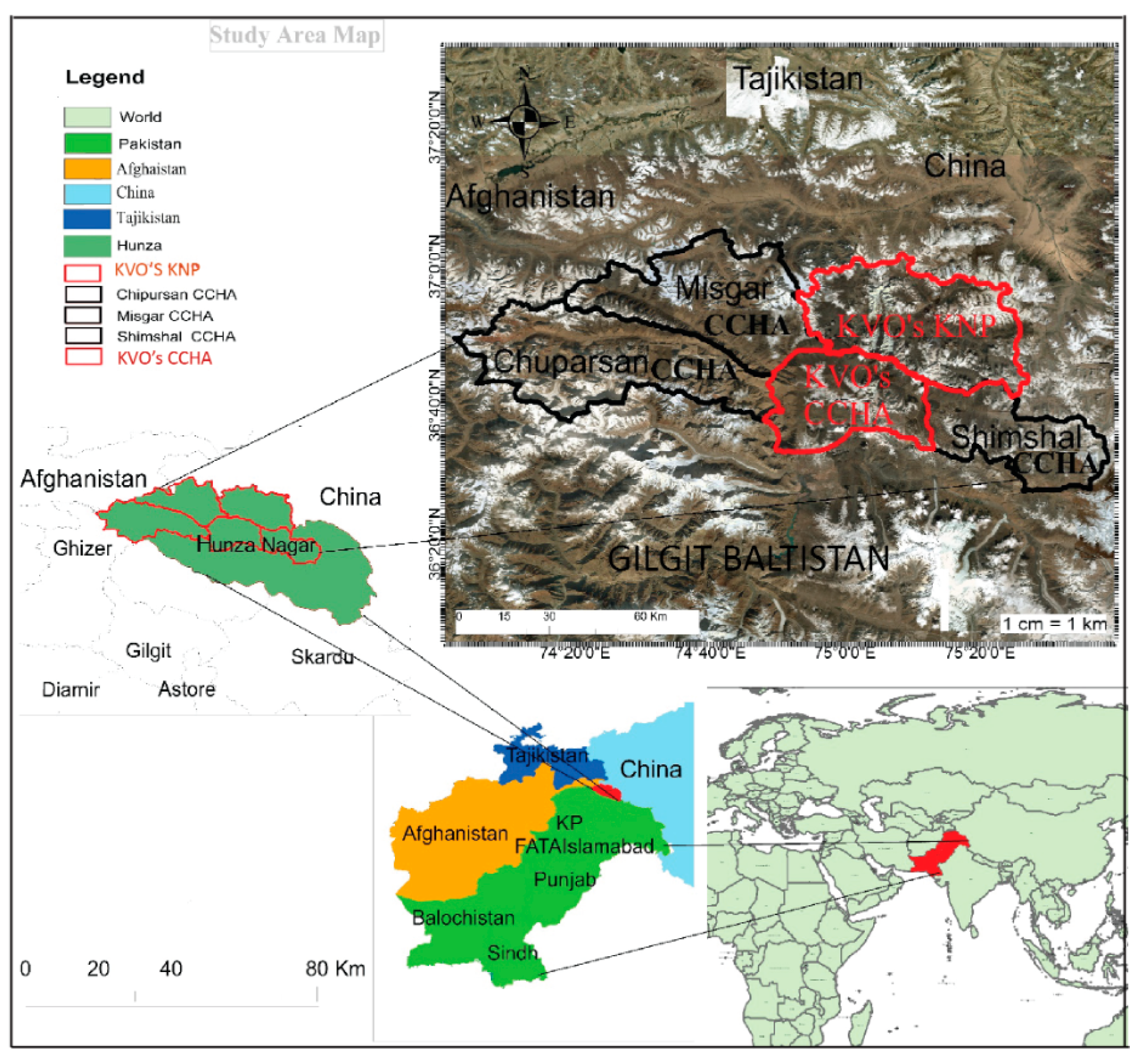
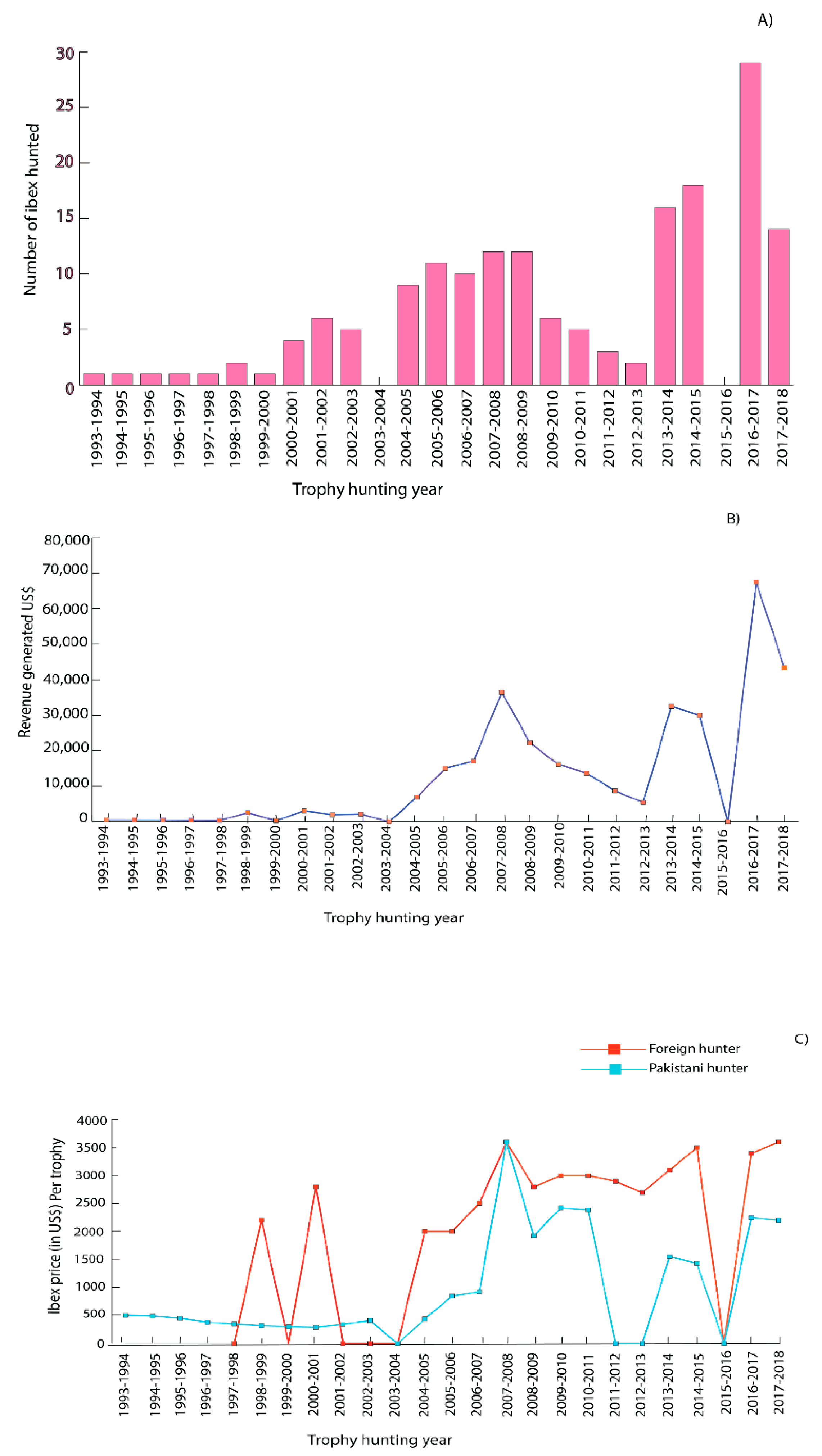
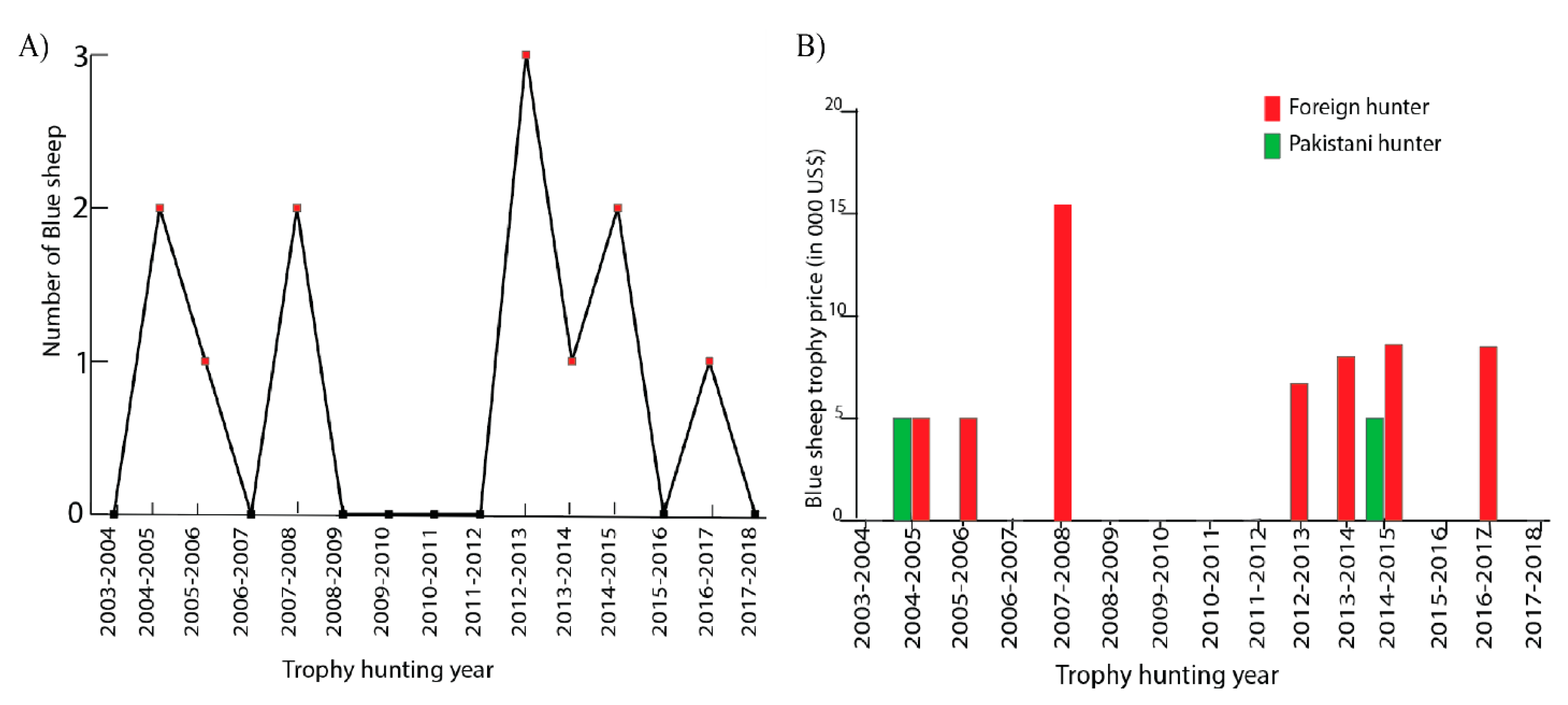
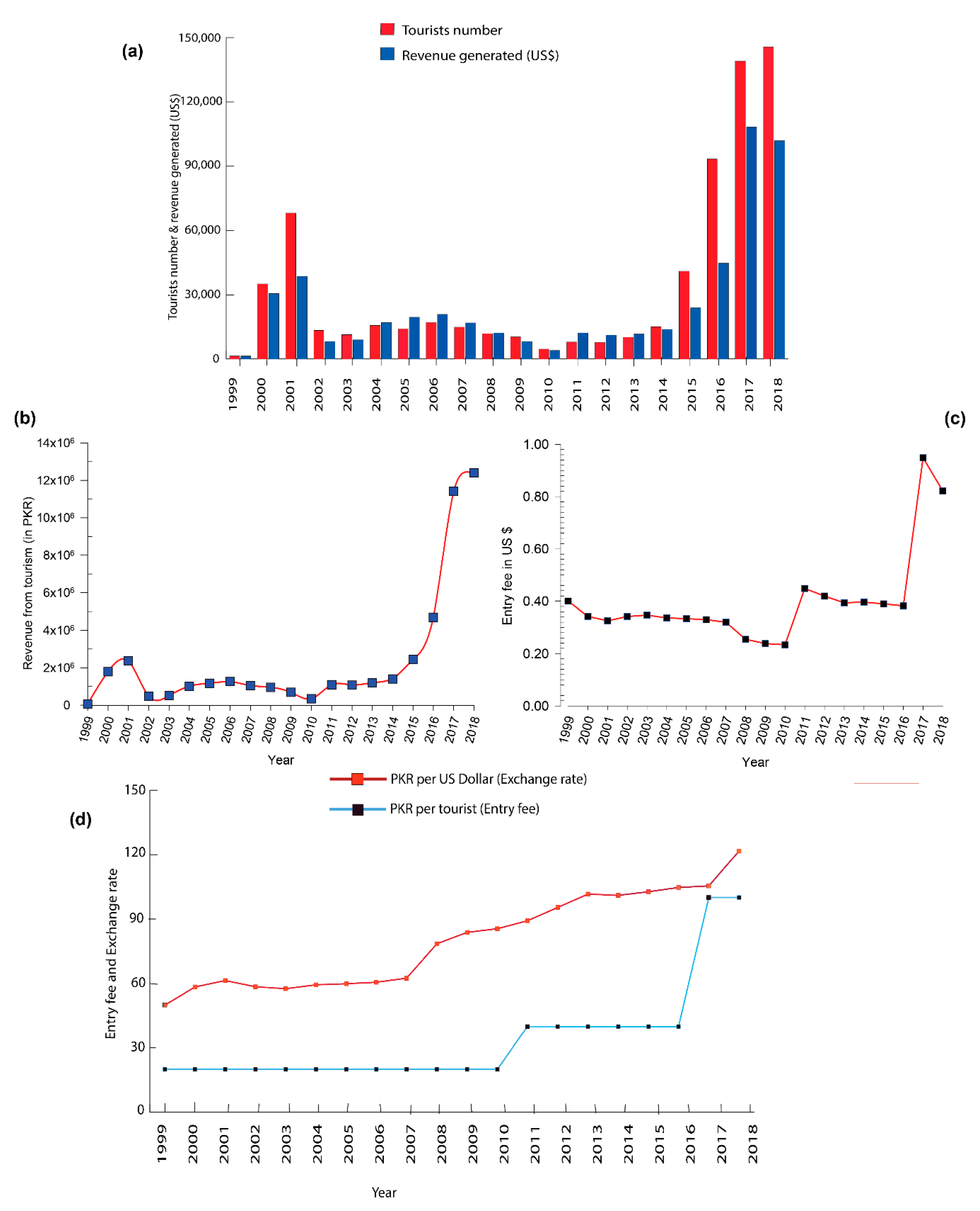
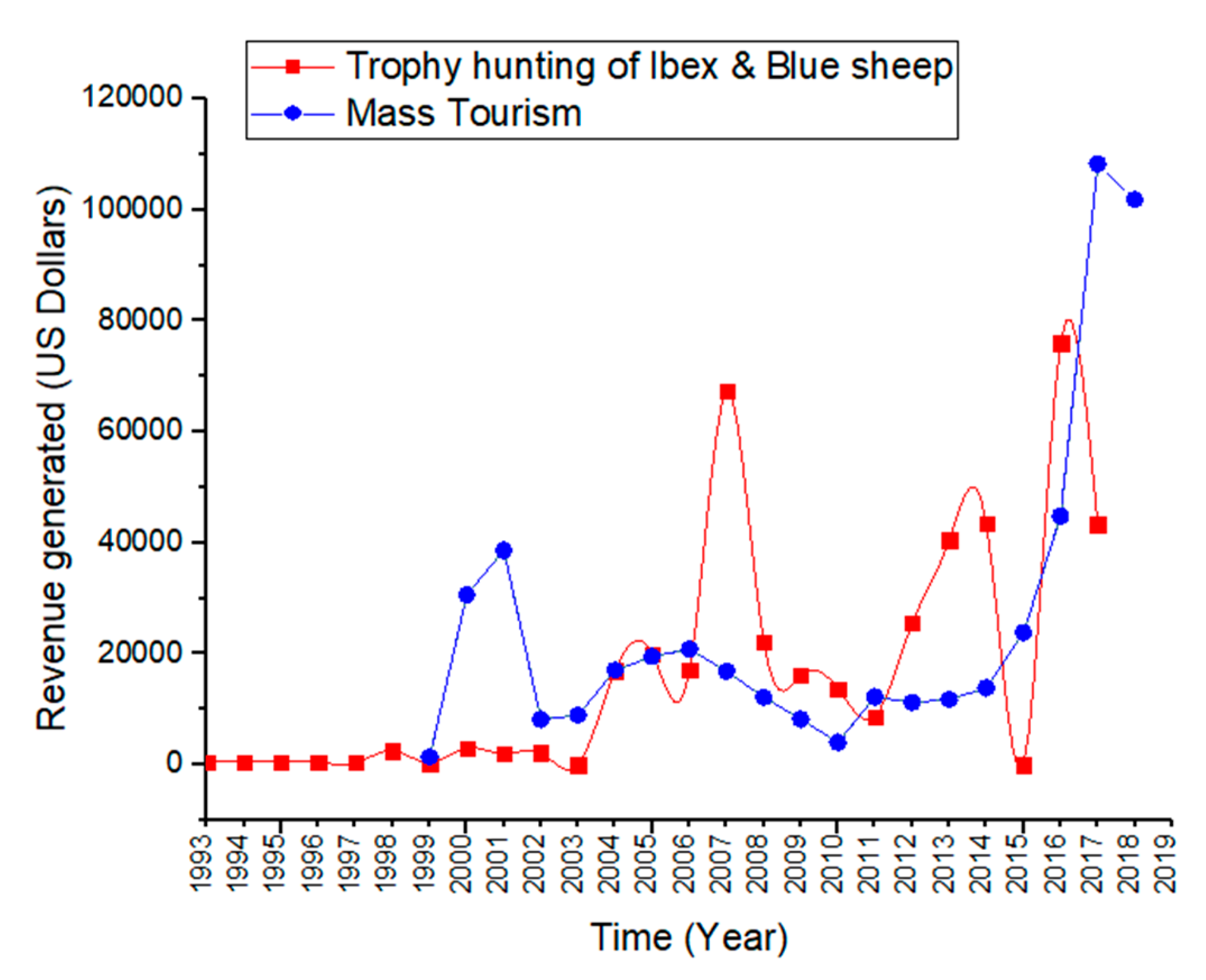
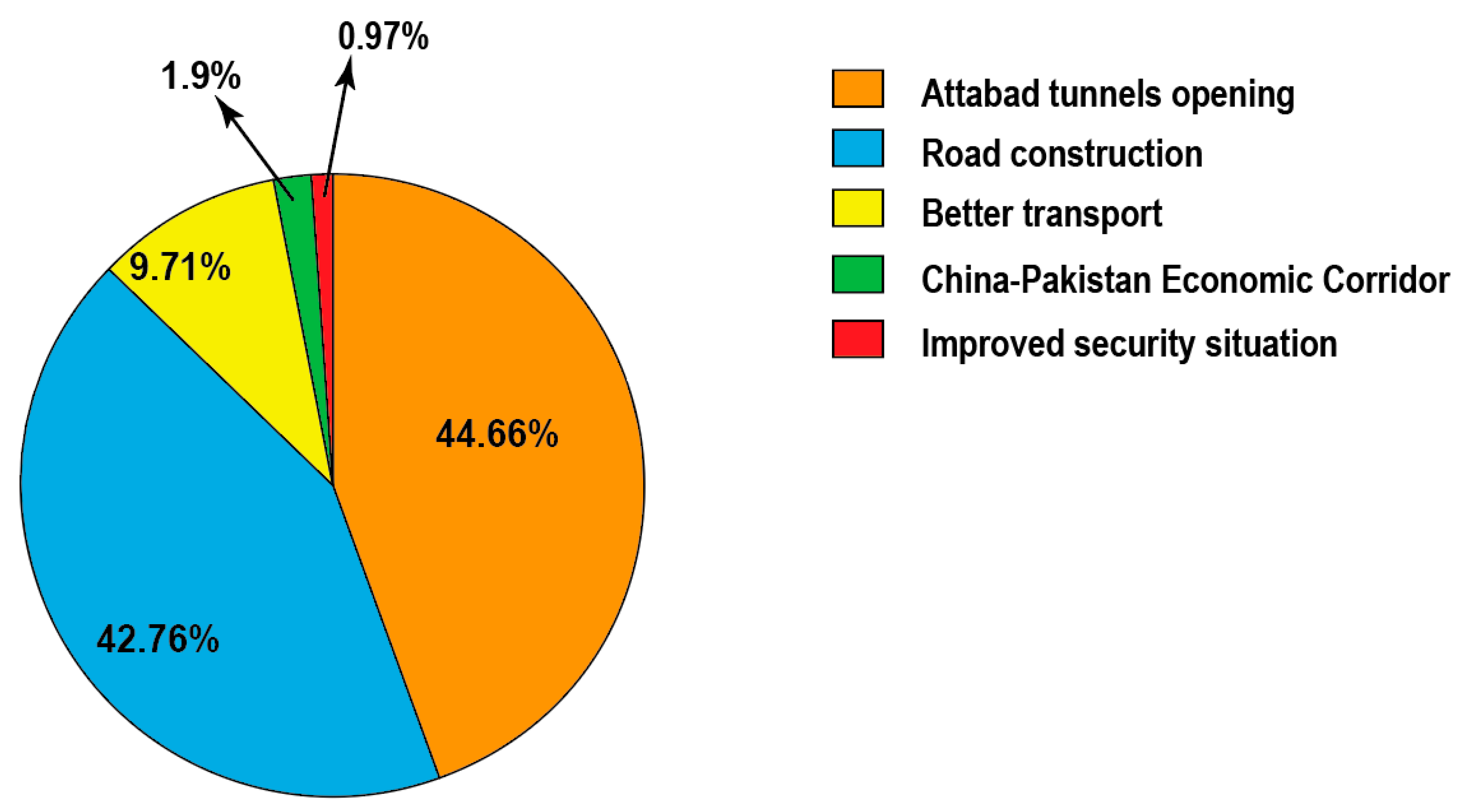
| Category | KVO Officials FGD 1 | National Park Staff FGD 2 | Local Community | Total | ||
|---|---|---|---|---|---|---|
| FGD 3 | FGD 4 | Sub-Total (FGD 3 & FGD 4) | ||||
| No. of participants | 7 | 5 | 6 | 7 | 13 | 25 |
| Age range (years) | 37–55 | 25–43 | 28–48 | 30–67 | – | – |
| Location of FGDs | Sost Bazar | Dhee post | Morkhun village | Sost village | – | – |
| Gender | All males | All males | All males | All males | – | – |
| Number of Ibex should increase | – | – | 6/6 | 7/7 | 13/13 | 13/13 |
| Number of Blue sheep should increase | – | – | 6/6 | 7/7 | 13/13 | 13/13 |
| Number of Snow leopards should decrease | – | – | 4/6 | 5/7 | 9/13 | 9/13 |
| Number of Wolves should decrease | – | – | 6/6 | 7/7 | 13/13 | 13/13 |
| Opinion about Snow leopards as pest animals in trophy hunting area | – | – | 5/6 | 5/7 | 10/13 | 10/13 |
| No compensation scheme for depredation loss | 7/7 | – | 6/6 | 7/7 | 13/13 | 20/20 |
| Benefits of trophy hunting | 7/7 | – | 6/6 | 7/7 | 13/13 | 20/20 |
| Disadvantages of trophy hunting | 7/7 | 0/6 | 0/7 | 0/13 | 7/20 | |
| Problems due to mass tourism | 7/7 | 5/5 | – | – | – | 12/12 |
| Suggestion for Snow leopard conservation | Alternative conservation to replace trophy hunting | – | Compensation scheme | Insurance of livestock | – | – |
| Month (Year) | Description | By Whom | Exact Location Where Snow Leopard(s) Was Killed |
|---|---|---|---|
| May or June 2011 | One Snow leopard was killed in retaliation for mass killing of sheep and goats. | Livestock herders | Dhee Nala, Khunjerab National Park |
| 2014 | The hunters injured two Snow leopards. One died on spot, while the other died later. | Illegal hunters | Ghalapan, Khunjerab valley |
| 2014 | One Snow leopard was killed in retaliation | Farmers | Abgarch Khunjerab valley |
| February 2014 | One Snow leopard was killed inside a livestock corral | Locals community | Yarzghirch, Chipursan, near Khunjerab National Park |
| March 2014 | Two Snow leopards were killed inside livestock corral. | The locals | Kirman, Chipursan near Khunjerab National Park |
| 23 June 2014 | Four Snow leopards were killed by burning inside a cave. Petrol was used to make a flame and they were burned alive. | Locals | Boybur valley, Jamalabad, Khunjerab valley |
| December 2014 | One Snow leopard was killed in Khuda abad near Sost area. The illegal hunter carried that Snow leopard and asked some locals to help in stuffing the Snow leopard hide. | Illegal hunter | Khuda abad, Sost, Khunjerab valley |
| 2016 | One Snow leopard was killed in retaliation for killing the livestock in the valley | Local farmers | Misgar Valley bordering Khunjerab National Park |
| Total | 13 |
| Livestock Species | Number of Livestock (n) | Mean ± SD | No. of Livestock Depredated | Mean ± SD |
|---|---|---|---|---|
| Yak | 154 | 1.5 ± 3.7 | 18 | 0.17 ± 0.5 |
| Goats | 677 | 6.4 ± 9.9 | 47 | 0.44 ± 1.3 |
| Sheep | 808 | 7.6 ± 8.8 | 52 | 0.49 ± 1.3 |
| Cows | 305 | 2.8 ± 1.6 | 8 | 0.08 ± 0.4 |
| Total | 1944 | – | 125 | – |
© 2020 by the authors. Licensee MDPI, Basel, Switzerland. This article is an open access article distributed under the terms and conditions of the Creative Commons Attribution (CC BY) license (http://creativecommons.org/licenses/by/4.0/).
Share and Cite
Rashid, W.; Shi, J.; Rahim, I.u.; Dong, S.; Sultan, H. Issues and Opportunities Associated with Trophy Hunting and Tourism in Khunjerab National Park, Northern Pakistan. Animals 2020, 10, 597. https://doi.org/10.3390/ani10040597
Rashid W, Shi J, Rahim Iu, Dong S, Sultan H. Issues and Opportunities Associated with Trophy Hunting and Tourism in Khunjerab National Park, Northern Pakistan. Animals. 2020; 10(4):597. https://doi.org/10.3390/ani10040597
Chicago/Turabian StyleRashid, Wajid, Jianbin Shi, Inam ur Rahim, Shikui Dong, and Hameeda Sultan. 2020. "Issues and Opportunities Associated with Trophy Hunting and Tourism in Khunjerab National Park, Northern Pakistan" Animals 10, no. 4: 597. https://doi.org/10.3390/ani10040597
APA StyleRashid, W., Shi, J., Rahim, I. u., Dong, S., & Sultan, H. (2020). Issues and Opportunities Associated with Trophy Hunting and Tourism in Khunjerab National Park, Northern Pakistan. Animals, 10(4), 597. https://doi.org/10.3390/ani10040597






